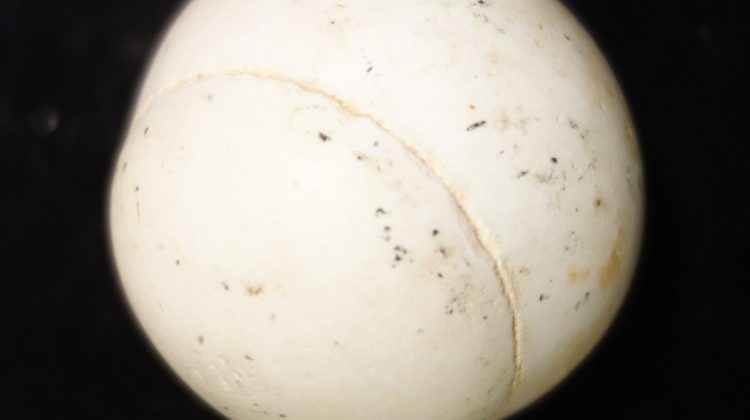
Have you ever seen something similar to this in an antique store, flea market, or yard sale and wondered what it is? And have you seen the same kind of ball in a shop but then heard very different back stories about what they are, how old they are, where they come from, and how they were used? We certainly have.
There is no “general rule” for the stories you will hear about these spheres, but one common theme is that they are “river balls”. In Georgia you will probably also hear that they were once used in Atlanta to help filter and purify city water from the Chattahoochee River.
Chattahoochee River
“The Chattahoochee River originates in the southeast corner of Union County, Georgia, in the southern Appalachian Mountains and flows southwesterly through the Atlanta metropolitan area before terminating in Lake Seminole, at the Georgia-Florida border. The river runs for a total distance of about 434 miles. The river joins with the Flint River as the two flow across the Georgia-Florida border, and the name changes to the Apalachicola River, which flows on to the Gulf of Mexico. The entire basin is often referred to as the Apalachicola-Chattahoochee-Flint (ACT) basin.”[1]
We have camped and hiked along both the Chattahoochee and Flint Rivers and both have some remarkably scenic stretches.“River Balls” & Chattahoochee Gems
River Balls and Chattahoochee Gems
The name “River Balls” is generally applied to any of these “porcellaneous” (sometimes even called porcelain) “marbles”. We will return to our odd feature photograph in a bit, but first let’s look at a river ball.
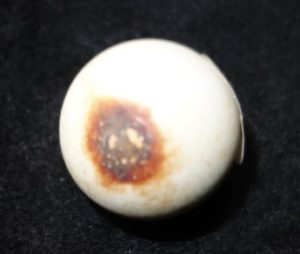 There is no “one size” ball. There are many sizes often depending on where and how they were used. We have seen reports online that the “Chattahoochee River Gems” are all 3” and that they weigh about a pound. Some are. However, these balls are really several different sizes. Some, in fact, are perfect marble shooter size for children who find them and use them as game marbles.
There is no “one size” ball. There are many sizes often depending on where and how they were used. We have seen reports online that the “Chattahoochee River Gems” are all 3” and that they weigh about a pound. Some are. However, these balls are really several different sizes. Some, in fact, are perfect marble shooter size for children who find them and use them as game marbles.
Starting At The End
We bought this river ball in February 2018 at Our House Antiques & Collectibles in Rockmart, Georgia, which is less than 50 miles north-northwest of Atlanta. Like all river gems, this one feels cold to the touch. It is smooth, 1⅛” in diameter, and while it “feels heavy”, it only weighs 1¾” ounces. We like the spot of iron stain, oxidization, or rust, although we cannot imagine it was transferred while the ball was part of the aquifer. Someone must have saved it in a coffee or tobacco can. Spots like these do add to the historical look of these old balls.
Since we have a record of where we bought this “Chattahoochee river gem,” and since the owners were our friends, we are confident that it was used in the Atlanta Water Works in the late 1800s. However, these aqua filtration balls were also used on the Chattahoochee in Columbus, Georgia, as part of their aqua filtration system which, technically, is referred to as slow sand filtration.
We know similar aqua filtration balls have been found in South Carolina and along the Beaver River in Upstate New York. If you bought them somewhere with a solid back story or if you found some along another river system then please press the “Contact” button and let us hear from you!
Water Filtration Balls
Wherever they are found, these water filtration balls were used to filter mud and sediment from the river water to prepare the water to drink. They are historical, and we have seen reports that the old aquifer in Atlanta is now completely depleted of “River Gems.”
One reason that these spheres are so popular is that they are now used in home décor in a variety of different containers. Remember, they often have colored stains, like the one shown, and they are different sizes and colors. While some are “rustic” and hardly white at all, the bright white ones refract the light all around a room.
The Atlanta Water Works built their inert water system in the late 1800s; Columbus followed in the 1920s. The filtration system was made up of a base layer, probably of sand, and then layers of these smaller balls, larger 3” balls, gravel, charcoal and then sand.[2]
Are These Things Natural?
What are these things made of, really? These old river gems are not made of porcellaneous stoneware nor the natural stone marble. They do not form naturally; they were manufactured. Remember, the balls were used to absorb some impurities from the river water.
So, your first reaction may be “Well since they were used in aqua filtration, of course they can’t be marble: marble isn’t porous.” But it is. Marble has a porosity ratio of between 0.5% – 2%. However, the aqua balls were made of limestone (some say sandstone) in part because of limestone’s higher porosity: between 0.6% – 31%.[3] Sandstone has the highest porosity of all three at 10% – 35%. We have seen reports of “rough” river balls, but most are smooth like this one.
Improved Filtration Led to Better Health & Fewer Deaths
Filtered and cleaner water sources and other public sanitation measures in the 19th century led to a dramatic drop in water borne diseases. While these diseases have not been eliminated world-wide, significant progress has been made.
There were six cholera epidemics worldwide in the 19th century.[4] Cholera is caused by a bacterium which spreads through contaminated food and water. Typhoid Fever was also a scourge throughout the United States. It, too, is a bacterium and it too is spread by contaminated water and food.
“In the late nineteenth century and throughout the twentieth century, sanitary practices were established in the United States regarding the handling and disposal of sewage, while filtration and chlorination systems were increasingly used to disinfect drinking water. Through these historical efforts and owing to ongoing advances in water and wastewater treatment and source water protection, the United States has secured and maintains one of the cleanest and safest supplies of drinking water in the world.”[5]
We simply cannot overstress the importance of the “Chattahoochee Gems” to the filtration of water sources and thus the reduction in water borne diseases.
Other Oddities
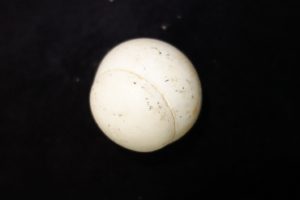 While you may have seen or even dug something like this, you have to admit that it certainly doesn’t look like the river balls that we’ve discussed so far. That’s because it isn’t, although you might find these mixed in with water balls in a shop. And, again, they are coveted for home décor.
While you may have seen or even dug something like this, you have to admit that it certainly doesn’t look like the river balls that we’ve discussed so far. That’s because it isn’t, although you might find these mixed in with water balls in a shop. And, again, they are coveted for home décor.
We bought this one in Andersonville, Georgia, at Antiques and More LLC in the Civil War Village in 2018. The shop owner had a basket of what she called “ceramic balls.” The backstory is that an older gentleman from the area (Sumter County) told her that he had found them when he was much younger in a pile of such balls on a mine site. We have the name of the mine in our records.
Clay Minerals Like Bauxite Used to Make Marbles
We were surprised when we got home to learn that bauxite mining has historical roots in the Andersonville area. Bauxite is an aluminum ore, rich in aluminum hydroxides. It often occurs as a reddish-brown material. Kaolin, a clay mineral sometimes used to make marbles, is also found alongside bauxite in this region.
And historically there were many mines in the Sumter area: English, Ideal, Hatton or Old Sweetwater, Thigpen Mines, Boggy Branch, and Easterlin, to name a few. The report Bauxite Deposits of the Andersonville District Georgia Distribution, Occurrence, & Resources of Bauxite (Geological Survey Bulletin), written by Alfred D. Zapp and published by the US Government Printing Office, Washington, DC, in 1965, is especially informative[6].
Are
We have no doubt that balls like this are still lying about at these old mine sites. Of course, we also have no idea whether or not these historical sites now have restricted access.
This ball is ceramic and we have the distinct impression that balls like this were often salvaged by local children and used as toys. This ball weighs a bit more than 8 oz or 220g! The base is 2” while there is a line and a high dome of 1⅝”.
Ok, this one is not a river ball and it came from a mine. What is it? Extensive research has shown that such balls on mine sites have been and are being used as equipment ball bearings in very large and heavy mining equipment!
Ceramic Ball Bearings
You may know much more about this than we do, but we had no idea that ceramic balls could be used as bearings! Microsoft Bing tells us that ceramic bearings were made of different kinds of ceramic to include alumina and silican nitride. The smooth surface reduces friction. Evidently, the odd groove on our marble was manufactured to hold the ball in place inside the cage as shown here.
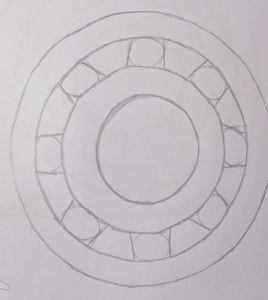
This sketch by Jurissa Chambers shows the cage for the bearings and the position of the balls inside the cage.[7]
Historically, ceramic balls were even used as cannonballs! We would love to find one of those. Modern ceramic bearings are harder than steel and this helps to extend their life. They are also corrosion resistant and this, of course, would really help in any mine work. These bearings are lighter weight than steel bearings and have a high temperature tolerance. They are used in mining on conveyor systems, crushers, and drilling equipment.[8]
Ceramic balls similar to these are also used in gas turbines, machine tool spindles, windmill generators, pumps, formula 1 racing cars, electric motors, ball point pens, jet engines, and even in skate board wheels!
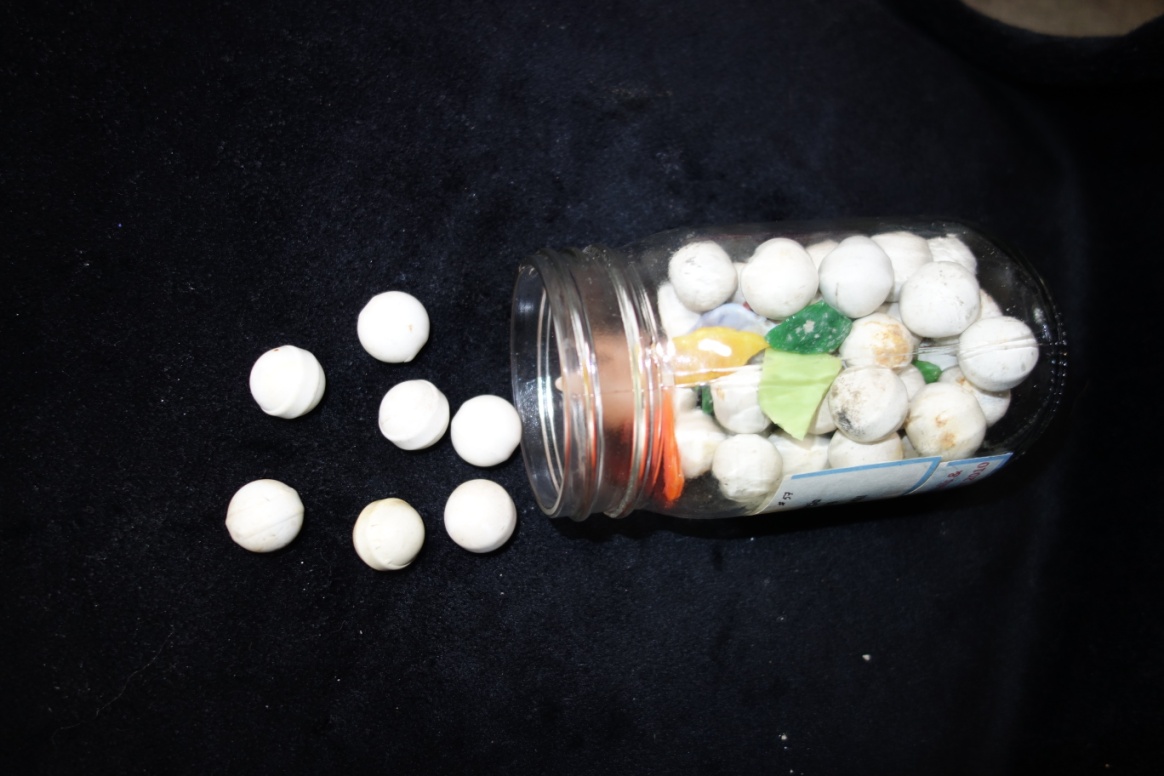
Griffin, Georgia, Finds
We found the ceramic balls above at an old mill site in Griffin, Georgia, in 2009 – 2011. Look carefully at the photos. There are two different kinds of ceramic balls. The jar with the lid contains ceramic balls which are 13/16” in size and which weigh ¾ oz. They are not as shiny as the water balls or the ceramic bearings, but they are perfect marble size! These ceramic balls are also extremely desirable by home decorators and are often just mixed in with the other balls for effect. They certainly do look historical.
And they are a bit odd. They look very old. But if these were used in some type ball mill then they must not be as old as they look. The ones in the left photo apparently have a thin layer of ceramic over some type metal. Some industrial applications use ceramic bearings inside a metal cage, but we cannot determine exactly why these are metal, possibly steel, covered in ceramic.
Surely someone reading this will know and press that Contact button!
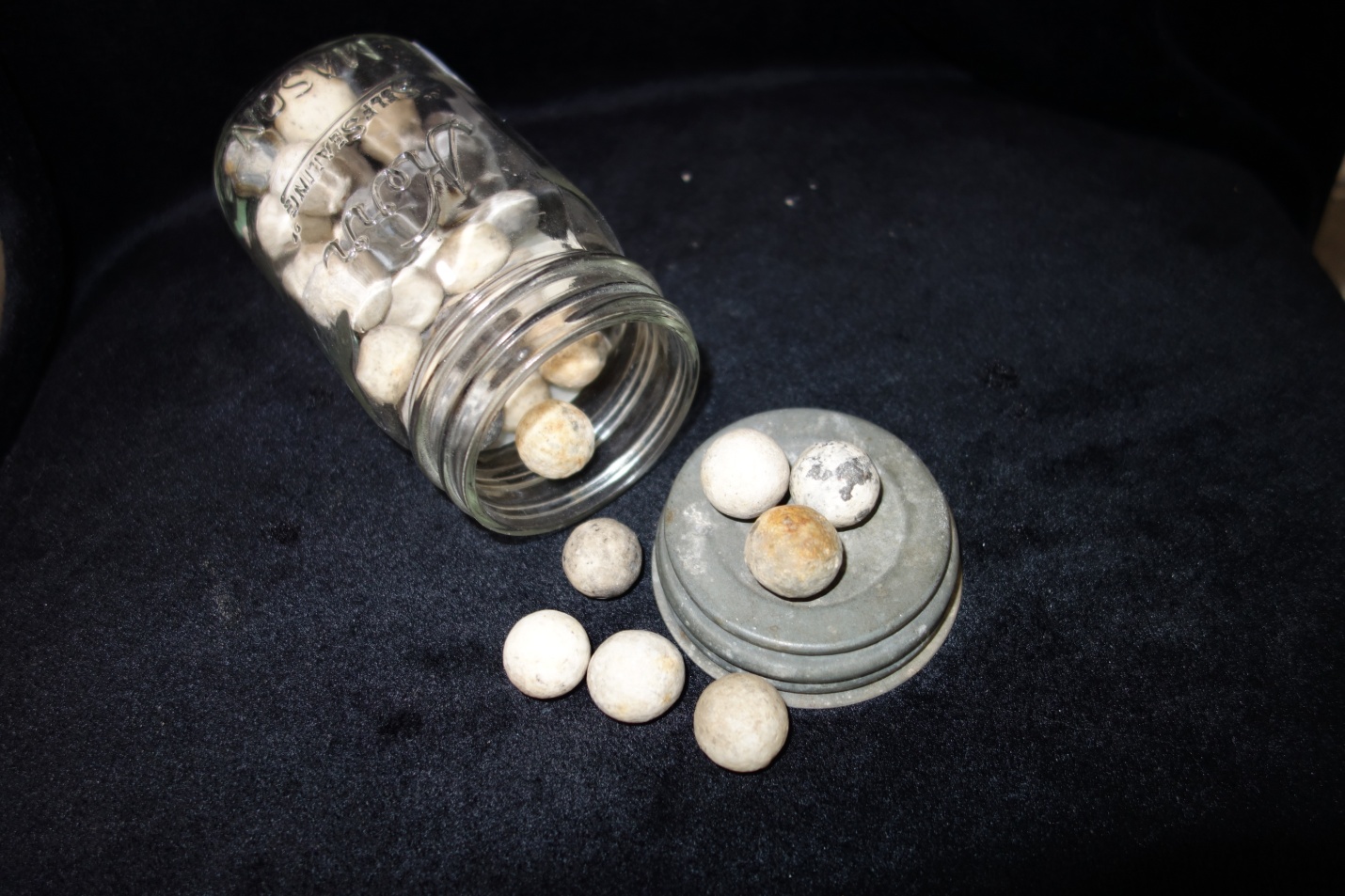
What is that?
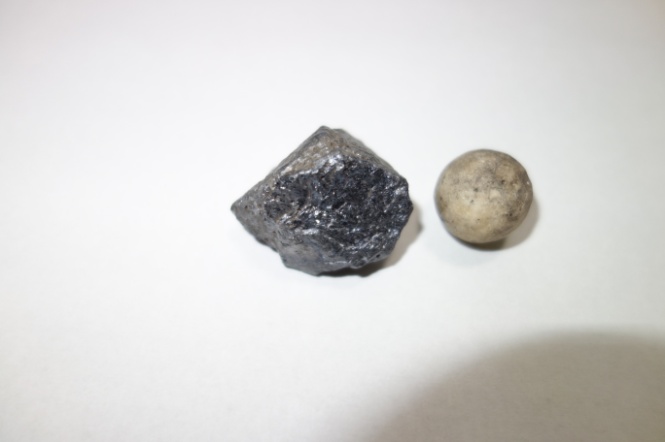 It is not at all unusual when collecting ceramic balls, ball bearings, and ball mill balls[9] to find other oddments. In fact, you should probably look for them. For example, in Griffin while collecting the ceramic balls we also found a fragment of what may be slag or tailings from some type mining or industrial work. We can only imagine that the mineral was brought to Griffin by rail to use at the workshop.
It is not at all unusual when collecting ceramic balls, ball bearings, and ball mill balls[9] to find other oddments. In fact, you should probably look for them. For example, in Griffin while collecting the ceramic balls we also found a fragment of what may be slag or tailings from some type mining or industrial work. We can only imagine that the mineral was brought to Griffin by rail to use at the workshop.
At the time we thought that the shiny dark mineral in the photograph was Sphalerite, which is the chief ore in zinc. Sphalerite is largely made up of zinc sulfide in crystalline form, but it does also contain iron. The iron contained in this sample is high and it may be a variety called marmatite. The shard weighs 10 grams.
We have also been told that the mineral may be raw hematite which does contain more iron than Sphalerite. Hematite is an iron oxide mineral and we don’t see enough “red” in our sample to call it Hematite.
We also found lead slag at the site which weighs 1¼ oz and which has an odd shape. At a Civil War site it would be called “camp lead”. It is slag and it has been smelted.
Looking Back & Looking Forward
Ok. We now have a guide to ceramic river balls, ceramic ball bearings, and ball mill balls. Now we know better what we are looking at in shops and flea markets. We hope you add some to your marble collection. Larry’s only regret when buying them is that we didn’t buy a few more!
And now that we have some appreciation of how these historic balls have helped revolutionize water sanitation and how they have spurred innovation and improvements across industry and mining. But what in the world do any of these have to do with toy marbles?
In a word: everything.
923 Johnston Street?
It may seem odd but every time we have seen any of these ceramic balls we have thought about marbles. However, we had to admit that there was no logical reason to think this way. How could these ceramics ever have any practical relationship to toy marbles?
In our story “A.L. Dyke: Man of Mystery” (https://thesecretlifeofmarbles.com/a-l-dyke-man-of-mystery/) we mentioned Frank J. Brown and his contributions to toy marble history with his clay marbles. We also noted that Michael Cohill had written an essay on Brown[10] and his Standard Toy Marble Company in Akron.
Since this information is already published we will not spend a great deal of time examining Brown’s life, but we will concentrate on his marble contributions and on the expanded possibilities which he opened up with his clay marbles.
Brown established the Standard Toy Marble Company in Akron, Ohio, in 1893. Before that, Cohill tells us, he was a skilled potter who worked at Knapp’s pottery and who started working with marbles in 1892 as a foreman with Samuel Dyke at the Dyke Marble Company in Akron.
The Akron City Directory 1893 – 1894, The Burch Directory Co., Akron, reports Brown living at 249 Johnston Street with his wife Helen. He is reported to be working as the foreman of an unnamed marble company. This must have been Dyke Marble. The 1895 Directory lists the Standard Marble Company at Brown’s residence 249 Johnston.
A Meeting Of The Minds
After working with Dyke for awhile, Brown obtained a license to manufacture marbles from Sam Dyke and a license to use Matthew Lang’s injection molding process.[11] We believe that these licenses are United States Patent licenses. “Patent licensing is an agreement between a patent owner (licensor) and a licensee. The licensor grants the licensee certain rights to use, make, or sell the patented invention. It allows the licensee to benefit from the intellectual property rights without having to develop the invention themselves.”[12]
A Family Affair
These license agreements were a brilliant move by Brown. We have studied him for some time now and we have the distinct impression that, while Brown and his family were in business in Akron throughout the exciting decade of the 1890s, he managed not to become involved in the whirlwind of patents, inventions, quick profits, speculation, and short-lived marble companies.
He established his business on Johnston Street on his  own property. As he established the Standard Toy Marble Company he used family members, including his daughters, to cut labor costs, and he used his own home as an office.
own property. As he established the Standard Toy Marble Company he used family members, including his daughters, to cut labor costs, and he used his own home as an office.
These images of women and girls working in the Standard Marble Company are from the Brick and Clay Record in 1911.[13]
He was obviously an astute business man and he was also a family man. Brown quickly learned that girls were especially capable and quick to learn and to roll clay marbles (check Cohill).
“Brown started his concern in 1893, and kept steadily enlarging it until he sold out and retired 25 years later. Twice it burned down and was rebuilt during that period. The building which housed the packing room and the moulding room is still standing.”[14] This was written in 1936.
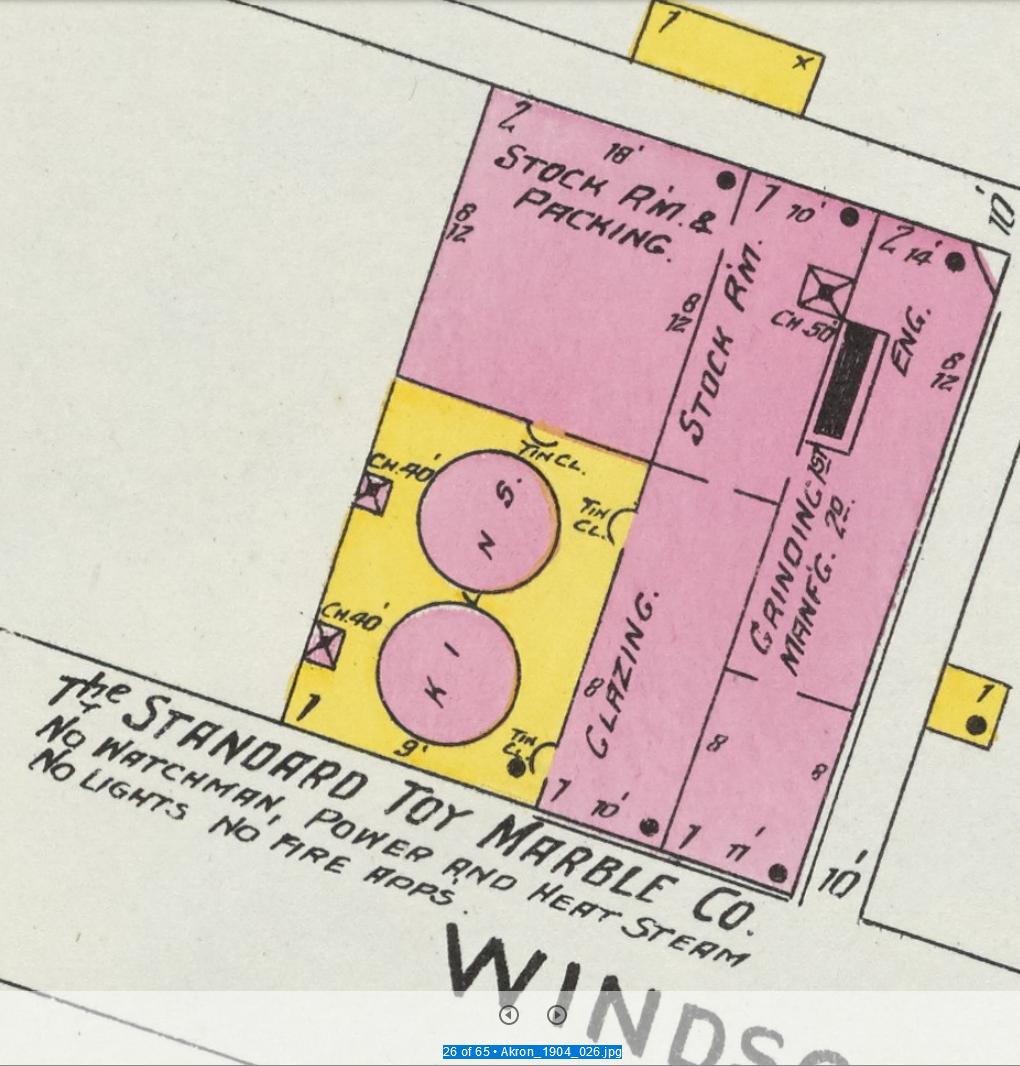
The Marble Company Faced Windsor Street
This is the Sanborn Fire insurance map of Akron in 1904. It shows the Standard Toy Marble Company facing Windsor Street. There is an alley running northeast to the right of the Company. Windsor intersects Johnston directly to the southeast. The Brown family lived on Johnston. Their home is just across the alley: only a few steps away[15]. We have read that the Marble Company eventually covered seven lots.

This second partial map shows the relationship of the home office to the factory. The home was at 247 Johnston Street.
Look at the first map portion which shows the Marble Company. It had two kilns in 1904; a Stock and Packing Room (you can see the women and girls packing in this room in the second photograph above); a second stock room; and finally a Grinding and Manufacturing Room. It was a busy place.
What Kind of Marbles Did the Browns Make?
Over time sixty girls and half a dozen men, as well as members of Brown’s family worked there. In fact one daughter, Mrs. Helen Dewey, recalled that “all but the two youngest of seven children were raised as marble makers” (AKB 1936).
And they made a lot of marbles! The Brick and Clay Record tells us that the Browns made an incredible 125,000,000 marbles a year! This is astounding to us; at least three marble factories were running in the 1890s in Akron. We have always wondered where in the world these marbles could have gone. Why don’t diggers or even scratchers like us find hands full of these little clay “pills” every time we venture out?
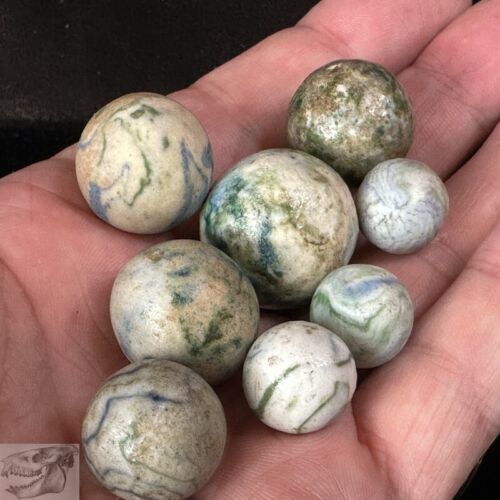 The Record also reports that “one girl who has acquired speed in her work can make from 25,000 to 30,000 marbles a day.” This operation is shown in the top photograph above. “As there are 50 rolls to a block the operator is paid six cents per thousand for the making of the common clay marble.” This “commie” is also called a “pill”.
The Record also reports that “one girl who has acquired speed in her work can make from 25,000 to 30,000 marbles a day.” This operation is shown in the top photograph above. “As there are 50 rolls to a block the operator is paid six cents per thousand for the making of the common clay marble.” This “commie” is also called a “pill”.
To our knowledge, the Browns never named any of their marbles. Names used were applied by the children themselves. Along with the commies there were “crockeries” and something called a “brownie”. The fire map clearly shows a large glazing room which leads us to believe that a brownie may be a brown-glazed “pill”. If so, it must look something like a small brown Bennington. If anyone knows for certain, please let us hear from you!
This photograph shows a group of eight crockeries[16]. While these were not made by the Browns, this is, we believe, one of the styles which they made. And, again, where are all these marbles? We have only ever found one crockery marble.
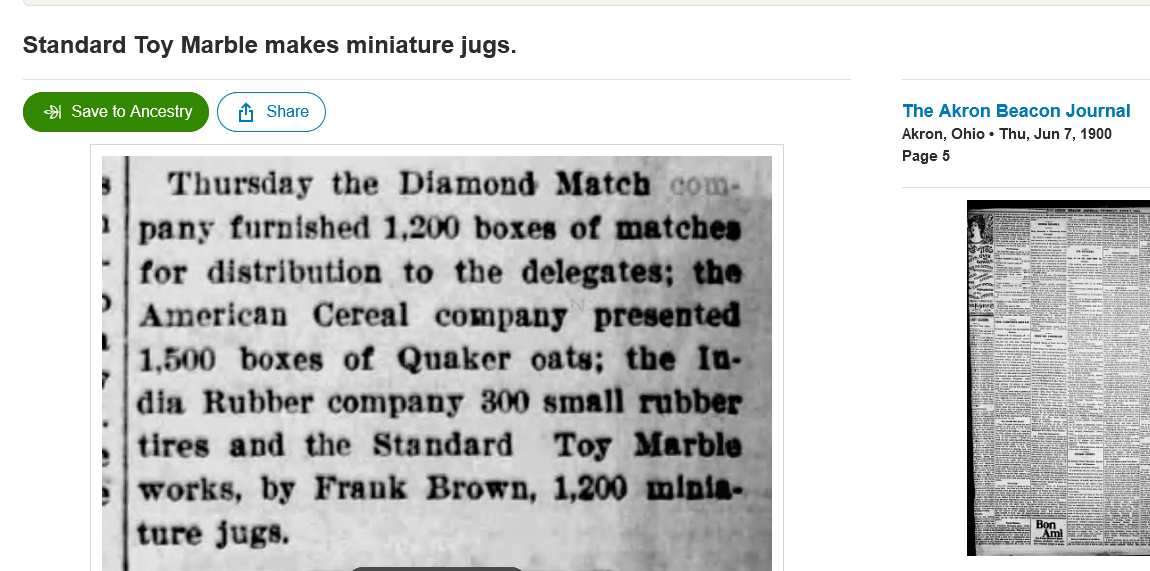
Councilman Brown
Even as his marble business was growing, Brown ran for City Council of Akron in 1896. His opponent in that first election was Matthew Lang. Remember, Brown had held a license to use Lang’s injection molding process. We have no idea whether or not he still held it in 1896. At any rate, Brown won the seat and held it until 1904 (Cohill). Just as Brown was a family man, a professional potter, and an astute businessman, he also proved to be a capable and dedicated public servant.
We have no idea how many delegates were in attendance at this 1900 meeting, but that is a lot of oats, “small rubber tires” and little brown jugs[17]! But this clipping does show that the Browns were both civic minded and community oriented.
1907
About 1907 Brown acquired a contract with the City of Akron. This contract proved to be both a first and fundamental in the transformation of the clay toy marble into another product altogether. The contract was to supply water filter marbles for the Akron waterworks at Kent.
The Brick and Clay Record tells us that the Browns continued to make toy marbles after the City of Akron purchase; and The Marble Connection[18] tells us that The Standard Toy Marble Company was the first to produce ceramic marbles primarily for inert municipal water systems.
We believe that the Browns continued to bake and color the industrial marbles as if they were making toys, and, as we learned above with inert sand filtration systems, the size of the marbles varied depending on the need. Some were small but they also produced marbles up to 6” in size; about the size of a small cannon ball.[19] To date we have not found a picture of this “ankle breaker”, but if anyone has one please do press the Contact button and let us see it! Thank you.
While this move of the Browns into industrial marble development seems low-key, it was the first time a toy marble maker had reached out to provide industrial marbles to any industry.
We told you a lot above about municipal water systems and how they dramatically cut the rate of critical diseases, especially in towns and cities. Also, we told you about different medium used for the inert filters. We have no idea what effect baking and coloring would have on the porosity and permeability of the clay marbles. But we do know that the clay marbles worked well in the Akron municipal water system.[20]
Salt & Puzzle-boxes!
The Brick and Clay Record: “The Standard Oil Company is one of the largest buyers of marbles, and these are used in oil cans, and larger sizes are used in graded pipe lines, to clean out the parafine (paraffin wax?[21]) which gathers to the side of the pipe as the oil flows to the tanks.
Clay marbles are also used by the manufacturers of rubber, ink, salt, chemicals, and powder. They are also used in the large stones in the lithographers’ plant and by railway supply people. Puzzle-box makers are also large buyers of marbles.”
The End-Of-Day
Frank J. Brown retired from the Company after 25 years in business. He died at 77 in 1936. His Obituary reported him as the one-time head of the world’s largest toy company and former Akron councilman. He was also a member of the Fifty Year club and of Grace Methodist church.
Brown died in Akron after falling down the cellar steps. He was sick for some six weeks after the fall and he died at home. He left thirty-four grandchildren and three great-grandchildren.
So, River Balls, Ceramic Bearings, & Ball Mill Balls Do Have a Marble Legacy
The Standard Toy Marble Company in Akron Ohio, and the Brown family, revolutionized clay marble production. They supplied marbles to the Akron Municipal Water authority and helped dramatically to reduce water-borne illnesses in America.
And their supply of marbles to all types of industry helped to spur industrial productivity and to increase efficiency of mechanical operations.
These historic marbles and “river balls” are still around for us to admire and to collect today. Whether you display them as a part of your marble collection or use them in home décor, we recommend that you stop for that extra few seconds when you see some at a yard sale or in an antique store. What kind is it? Is it old? What secrets and mysteries does it hold?
References
- https://garivers.org/chattahoochee-river/ (4/24/2024). We have hiked or camped along both the Flint & Chattahoochee and both are beautiful. ↑
- Chattahoochee River Ball – Zachary Ltd. 4/24/2024 ↑
- https://marble-concepts.com/porosity-stone-stone-porus/ (4/24/2024); https://home.wgnhs.wisc.edu/water/wisconsin-aquifers/understanding-porosity-density/ 4/24/2024 ↑
- Diseases and epidemics of the 19th century – Wikipedia (4/25/2024); Diseases in industrial cities in the Industrial Revolution (historylearning.com) 4/25/2024 ↑
- National Academies of Sciences, Engineering, and Medicine. 2004. Indicators for Waterborne Pathogens. Washington, DC: The National Academies Press. https://doi.org/10.17226/11010 4/27/2024 ↑
- https://pubs.usgs.gov/bul/1199g/report.pdf 6/22/2018 ↑
- So see modern ceramic bearings in a cage and to learn more you may check https://www.lily-bearing.com/product/ceramic-bearing / (4/25/2024). Thank you to Jurissa Chambers for the sketch! ↑
- You might want to check https://iskbearing.com/ (4/25/2024); and https://www.lily-bearing.com/ (4/25/2024). ↑
- “A ball mill is a type of grinder that uses metal balls or other grinding mediums to reduce the size of various materials. The material to be ground is placed in a cylindrical container that spins on its axis. As the container rotates, the metal balls or grinding media inside it hit the material, breaking it down into smaller particles.” Microsoft GPT-4. These mills have been around for generations and have been used to grind almost any type material that you can imagine such as mined ores and paint pigments. They are used either wet or dry. ↑
- Michael Cohill, “Frank Brown and the Standard Toy Marble Company.” @ Frank-Brown-The-Standard-Toy-Marble-Company.pdf (ohiobottleclub.org) 4/10/2024 ↑
- https://marbleconnection.com/topic/20575-the-standard-toy-marble-company/ 4/28/2024 ↑
- https://www.uspto.gov/ 4/30/2024 ↑
- “Making The Toy Marble, Brick and Clay Record, Vol. XXXVIII, No. 6, 1911. You can read the Record online @ Brick and clay record : Free Download, Borrow, and Streaming : Internet Archive 4/30/2024 ↑
- From Brown’s obituary. United States, Ohio, Akron, The Akron Beacon Journal, 1936, Apr 02, Page 16, Frank J Brown death P16 C2/3. Hereafter AKB 1936. ↑
- OPLIN – Sanborn Image Viewer (ohioweblibrary.org) Akron, Summit Co., Ohio. Image 79 of 118; Sheet Label 76. ↑
- Photo courtesy Ryan’s Rare Coins & Antiques, 4/22/2024. ↑
- Akron Beacon Journal, Akron Ohio, June 7, 1900, page 5. We still have no evidence of who “invented” these little brown jugs (and perhaps little boys and girls in Akron in the 1890s were asking “Why?”). Did Lang make the molds; the Dyke brothers; or someone else? Did anyone in Akron patent them? ↑
- The Standard Toy Marble Company – General Marble & Glass Chat – Marble Connection 5/3/2024 ↑
- Brick and Clay Record, page 321. ↑
- You might want to read the one page .PDF “Porosity and Permeability”. Permeability is a measure of the ability of the material, such as clay, to transmit fluids while porosity is the measure of the void spaces in a material. ↑
- Paraffin wax (or petroleum wax) isa soft colorless solid derived from petroleum, coal, or oil shale that consists of a mixture of hydrocarbon molecules containing between 20 and 40 carbon atoms.It is solid at room temperature and begins to melt above approximately 37 °C (99 °F)…. Paraffin wax – Wikipedia 5/3/2024 ↑

